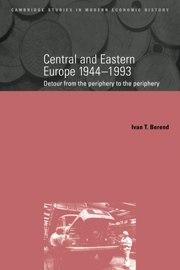Book contents
- Frontmatter
- Contents
- Preface
- Acknowledgments
- I Out from Europe: the introduction of state socialism, the Stalinist decades, and revolts against them
- 1 Communist seizure of power, 1944–8
- 2 The closed society in Stalinist state socialism after 1948
- 3 Reforms, revolutions, and the loosening bloc, the 1950s and 1960s
- II Temporary success and terminal failure: the post-Stalinist decades – modernization, erosion, and collapse
- III Back to Europe? Post-1989 transformation and pathways to the future
- References
- Names index
- Subject index
1 - Communist seizure of power, 1944–8
Published online by Cambridge University Press: 28 October 2009
- Frontmatter
- Contents
- Preface
- Acknowledgments
- I Out from Europe: the introduction of state socialism, the Stalinist decades, and revolts against them
- 1 Communist seizure of power, 1944–8
- 2 The closed society in Stalinist state socialism after 1948
- 3 Reforms, revolutions, and the loosening bloc, the 1950s and 1960s
- II Temporary success and terminal failure: the post-Stalinist decades – modernization, erosion, and collapse
- III Back to Europe? Post-1989 transformation and pathways to the future
- References
- Names index
- Subject index
Summary
Disrupted historical continuity
Fascism and nazism, which appeared in the interwar period, became dominant in Central and Eastern Europe during the tragic years of World War II. It occurred cither through nazi-German occupation or with the takeover of domestic nazi-fascist groupings. In most cases these two factors did not exclude but complemented each other. Independent countries (Poland, Czechoslovakia, Yugoslavia, and Albania) were annexed and ruled by a nazi (or partly Mussolini's) administration, others became allies of Hitler (such as Hungary, Romania, and Bulgaria), or were created by him (as “independent” allied Slovakia and Croatia), bringing to power long existing internal nazi-fascist parties.
The peoples of the region reacted in various ways. Heroic, self-sacrificing partisan warfare (especially in Yugoslavia and Albania) and dramatic uprisings (in Poland and Czechoslovakia), passive resistance as well as passive collaboration (in most of the countries), active cooperation in the annihilation of Jews (in Slovakia, Croatia, Hungary, Romania, and Poland) – these phenomena were present at the same time in each country.
The military aftermath of the war in 1944 and early 1945, as a result of the victorious advance of the Allied forces, including the Red Army in Central and Eastern Europe, led to a bloody and spectacular collapse of fascism. The decline and breakdown of Axis-regimes in Yugoslavia and Albania were brought about, or at least assisted, by the actions of internal partisan armies during the general course of the war. In other cases the process was accelerated by coups (Romania), which removed the local fascist government and resulted in a conversion to the Allied side, or brought about entirely by foreign troops (Bulgaria, Czechoslovakia and Hungary).
- Type
- Chapter
- Information
- Central and Eastern Europe, 1944–1993Detour from the Periphery to the Periphery, pp. 3 - 38Publisher: Cambridge University PressPrint publication year: 1996

